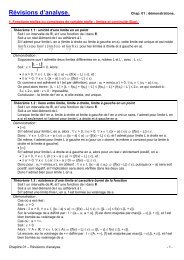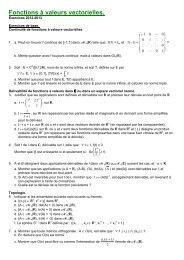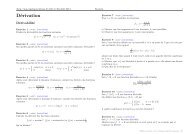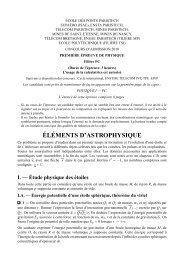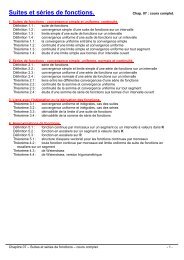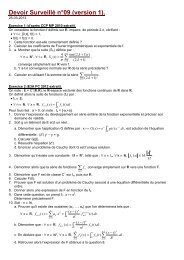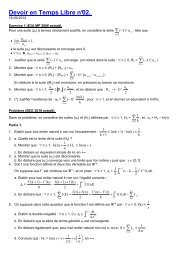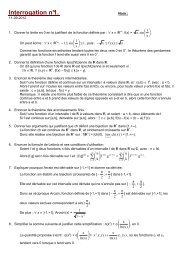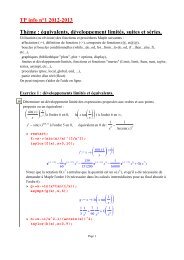Système de Cramer
Système de Cramer
Système de Cramer
Create successful ePaper yourself
Turn your PDF publications into a flip-book with our unique Google optimized e-Paper software.
[http://mp.cpgedupuy<strong>de</strong>lome.fr] édité le 26 juillet 2013 Enoncés 1<br />
<strong>Système</strong> <strong>de</strong> <strong>Cramer</strong><br />
Exercice 1 [ 01437 ] [correction]<br />
Soient a, b, c et d <strong>de</strong>s éléments <strong>de</strong> K <strong>de</strong>ux à <strong>de</strong>ux distincts.<br />
Résoudre sur K les systèmes suivants :<br />
⎧<br />
⎪⎨ x + y + z = 1<br />
a)<br />
⎪⎩<br />
ax + by + cz = d<br />
a 2 x + b 2 y + c 2 z = d 2<br />
⎧<br />
⎪⎨<br />
b)<br />
⎪⎩<br />
Exercice 2 [ 01438 ] [correction]<br />
Résoudre ⎧<br />
⎪⎨ x + y + z = a<br />
x + jy + j<br />
⎪⎩<br />
2 z = b<br />
x + j 2 y + jz = c<br />
en fonction <strong>de</strong> a, b, c ∈ C.<br />
Exercice 3 [ 01439 ] [correction]<br />
Résoudre en fonction <strong>de</strong> a ∈ C le système<br />
⎧<br />
⎪⎨<br />
x + ay + a<br />
⎪⎩<br />
2 z = 0<br />
āx + y + az = 0<br />
ā 2 x + āy + z = 0<br />
Exercice 4 [ 01440 ] [correction]<br />
Soient a, b, c ∈ C distincts.<br />
a) Résoudre<br />
⎧<br />
⎪⎨<br />
⎪⎩<br />
x + ay + a 2 z = a 3<br />
x + by + b 2 z = b 3<br />
x + cy + c 2 z = c 3<br />
en introduisant : P = X3 − (x + yX + zX 2 )<br />
b) Même question pour<br />
⎧<br />
⎪⎨<br />
⎪⎩<br />
x + ay + a 2 z = a 4<br />
x + by + b 2 z = b 4<br />
x + cy + c 2 z = c 4<br />
x + y + z = 1<br />
ax + by + cz = d<br />
a 3 x + b 3 y + c 3 z = d 3<br />
Diffusion autorisée à titre entièrement gratuit uniquement - dD
[http://mp.cpgedupuy<strong>de</strong>lome.fr] édité le 26 juillet 2013 Corrections 2<br />
Corrections<br />
Exercice 1 : [énoncé]<br />
a) On a <br />
1 1 1<br />
a b c<br />
a 2 b 2 c 2<br />
<br />
<br />
<br />
<br />
= (b − a)(c − a)(c − b) = 0<br />
<br />
Par les formules <strong>de</strong> <strong>Cramer</strong><br />
⎧<br />
(b − d)(c − d)(c − b)<br />
x =<br />
(b − a)(c − a)(c − b)<br />
⎪⎨<br />
(d − a)(c − a)(c − d)<br />
y =<br />
(b − a)(c − a)(c − b)<br />
⎪⎩<br />
(b − a)(d − a)(d − b)<br />
z =<br />
(b − a)(c − a)(c − b)<br />
b) On a <br />
1 1 1<br />
a b c<br />
a 3 b 3 c 3<br />
Par les formules <strong>de</strong> <strong>Cramer</strong><br />
et y, z par symétrie.<br />
x =<br />
<br />
<br />
<br />
<br />
= (b − a)(c − a)(c − b)(a + b + c) = 0<br />
<br />
(b − d)(c − d)(c − b)(d + b + c)<br />
(b − a)(c − a)(c − b)(a + b + c)<br />
Exercice 2 : [énoncé]<br />
Le système est <strong>de</strong> <strong>Cramer</strong> via déterminant <strong>de</strong> Van<strong>de</strong>rmon<strong>de</strong>.<br />
(1) + (2) + (3) donne<br />
(1) + j 2 (2) + j(3) donne<br />
et (1) + j(2) + j 2 (3) donne<br />
x =<br />
a + b + c<br />
3<br />
y = a + bj2 + cj<br />
3<br />
z =<br />
a + bj + cj2<br />
3<br />
Exercice 3 : [énoncé]<br />
Le déterminant du système est<br />
<br />
<br />
1 a a<br />
<br />
<br />
<br />
2<br />
ā 1 a<br />
ā2 <br />
<br />
<br />
<br />
<br />
ā 1 =<br />
<br />
<br />
<br />
1 a a<br />
<br />
<br />
<br />
2<br />
0 1 − |a| 2<br />
a(1 − |a| 2 )<br />
0 ā(1 − |a| 2 ) 1 − |a| 4<br />
<br />
<br />
<br />
<br />
<br />
=<br />
<br />
<br />
<br />
<br />
<br />
<br />
Si |a| = 1 alors est le système est <strong>de</strong> <strong>Cramer</strong> et homogène<br />
S = {(0, 0, 0)}<br />
Si |a| = 1 alors le système équivaut à une seule équation<br />
x + ay + a 2 z = 0<br />
car les <strong>de</strong>ux autres lui sont proportionnelles. On en déduit<br />
S = (−ay − a 2 z, y, z)/y, z ∈ C <br />
1 a a 2<br />
0 1 − |a| 2 a(1 − |a| 2 )<br />
0 0 1 − |a| 2<br />
Exercice 4 : [énoncé]<br />
Les <strong>de</strong>ux systèmes proposés sont <strong>de</strong> <strong>Cramer</strong> via déterminant <strong>de</strong> Van<strong>de</strong>rmon<strong>de</strong>.<br />
a) Si x, y, z est sa solution alors P (a) = P (b) = P (c) = 0 et donc<br />
On en déduit<br />
b) Introduisons<br />
P = (X − a)(X − b)(X − c)<br />
x = abc, y = −(ab + bc + ca) et z = a + b + c<br />
P = X 4 − (x + yX + zX 2 )<br />
Si x, y, z est solution alors P (a) = P (b) = P (c) = 0 et donc<br />
P = (X − a)(X − b)(X − c)(X − d)<br />
Puisque le coefficient <strong>de</strong> X 3 dans P est nul, la somme <strong>de</strong>s racines <strong>de</strong> P est nulle et<br />
donc<br />
a + b + c + d = 0<br />
puis<br />
En développant, on obtient<br />
P = (X − a)(X − b)(X − c)(X + (a + b + c))<br />
x = σ3σ1, y = σ3 − σ1σ2 et z = σ 2 1 − σ2<br />
avec σ1, σ2, σ3 les expressions symétriques élémentaires en a, b, c.<br />
Diffusion autorisée à titre entièrement gratuit uniquement - dD


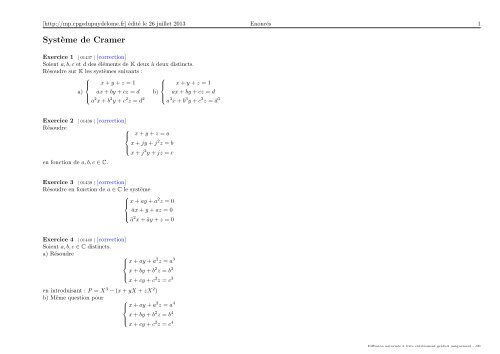
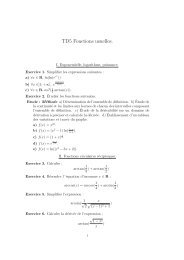
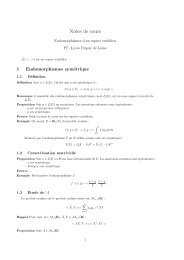
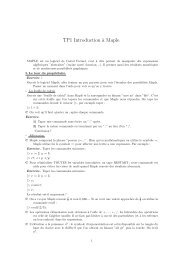

![[http://mp.cpgedupuydelome.fr] édité le 4 juin 2013 Enoncés 1 ...](https://img.yumpu.com/19249082/1/190x135/http-mpcpgedupuydelomefr-edite-le-4-juin-2013-enonces-1-.jpg?quality=85)
